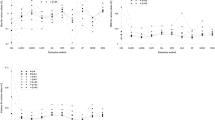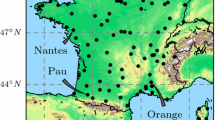Abstract
This article addresses the problem of modeling extreme wind speeds with the aim of develo** procedures that can be used to reliably identify outliers. There are several approaches to fitting extremes, including using maxima over a fixed time period or taking all observations over a threshold. Using two sets of oceanic wind data from buoys, we use robust estimation methods to estimate the parameters of the asymptotic distribution for extremes over fixed time periods and peaks over threshold. For both cases we also use a gh distribution which focuses on modeling the quantiles and propose a robust method for fitting the data to the gh distribution. Weights from the robust fits are used to identify outliers with P values being computed by resampling. We also evaluate the fits of the data to the model distributions according to several criteria concluding that the gh distribution is at least as effective in fitting the tail behavior as the more classical generalized extreme value distribution and the generalized Pareto distribution.
Similar content being viewed by others
References
Anderson, T. W., and Darling, D. A. (1954), “A Test of Goodness of Fit,” Journal of the American Statistical Association, 49, 765–769.
Bauer, E. (1996), “Characteristic Frequency Distributions of Remotely Sensed in situ and Modelled Wind Speeds,” International Journal of Climatology, 16, 1087–1102.
Cardone, V. J., and Greenwood, J. G. (1990), “On Trends in Historical Marine Data,” Journal of Climate, 3, 113–127.
Dupuis, D. J. (1998), “Exceedances over High Thresholds: A Guide to Threshold Selection,” Extremes, 3, 251–261.
Dupuis, D. J., and Field, C. A. (1998a), “Robust Estimation of Extremes,” Canadian Journal of Statistics, 26, 199–215.
— (1998b), “A Comparison of Confidence Intervals for Generalized Extreme Value Distributions,” Journal of Statistical Computation and Simulation, 61, 341–360.
Halpern, D. (1988), “On the Accuracy of Monthly Wind Speeds Over the Equatorial Pacific,” Journal of Atmosphere and Ocean Technology, 5, 362–367.
Hampel, F. R., Ronchetti, E., Rousseeuw, P., and Stahel, W. (1986), Robust Statistics, New York: Wiley.
Heritier, S., and Ronchetti, E. (1994), “Robust Bounded-Influence Tests in General Parametric Models,” Journal of the American Statistical Association, 89, 897–904.
Hoaglin, D. C., Mosteller, F., and Tukey, J. W. (1985), Exploring Data Tables, Trends and Shapes, New York: Wiley.
Hosking, J. R. M., Wallis, J. R., and Wood, E. F. (1985). “Estimation of the gGeneralized Extreme-Value Distribution by the Method of Probability-Weighted Moments,” Technometrics, 27, 251–261.
Hosking, J. R. M., and Wallis, J. R. (1987), “Parameter and Quantile Estimation of the Generalized Pareto Distribution,” Technometrics, 29, 339–349.
Huber, P. J. (1981), Robust Statistics, New York: Wiley.
Kent, E. C., Taylor, P. K., Truscott, B. S., and Hopkins, J. S. (1993), “The Accuracy of Voluntary Observing Ships’ Meteorological Observations—Results of the VSOP-NA,” Journal of Atmosphere and Ocean Technology, 10, 591–608.
Naess, A. (1998), “Statistical Extrapolation of Extreme Value Data Based on the Peaks Over Threshold Method,” Journal of Offshore Mechanics and Arctic Engineering, ASME, 120, 91–96.
Peterson, E. W., and Hasse, L. (1987), “Did the Beaufort Scale or the Wind Climate Change?,” Journal of Physical Oceanography, 17, 1071–1074.
Pickands, J. (1975), “Statistical Inference Using Extreme Order Statistics,” The Annals of Statistics, 3, 119–131.
Simiu, E., and Heckert, N. A. (1996), “Extreme Wind Distribution Tails: A ‘Peaks Over Threshold’ Approach,” Journal of Structural Engineering, ASCE, 122, 539–547.
Tukey, J. W. (1987), “Kinds of Bootstraps and Kinds of Jackknives Discussed in Terms of a Year of Weather Data,” Technical Report 292, Princeton University, Princeton, NJ.
Ward, M. N. (1992), “Provisionally Corrected Surface Wind Data, World wide Ocean-Atmosphere Surface Fields, and Sahelian Rainfall Variability,” Journal of Climate, 5, 454–475.
Author information
Authors and Affiliations
Corresponding author
Rights and permissions
About this article
Cite this article
Dupuis, D.J., Field, C.A. Large wind speeds: Modeling and outlier detection. JABES 9, 105–121 (2004). https://doi.org/10.1198/1085711043163
Received:
Revised:
Issue Date:
DOI: https://doi.org/10.1198/1085711043163




